RU Serial?

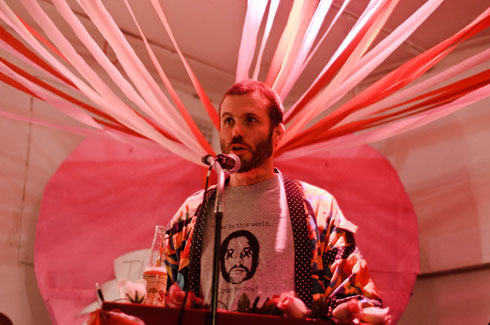
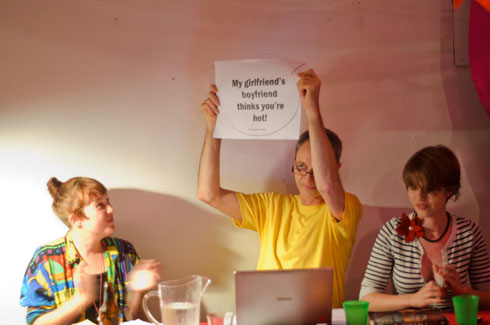
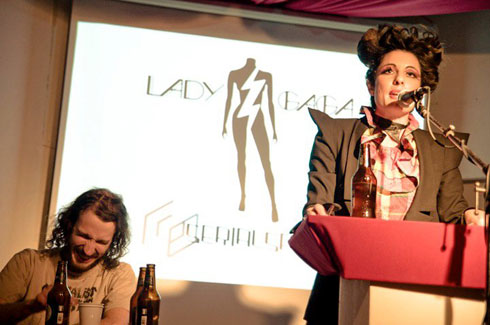
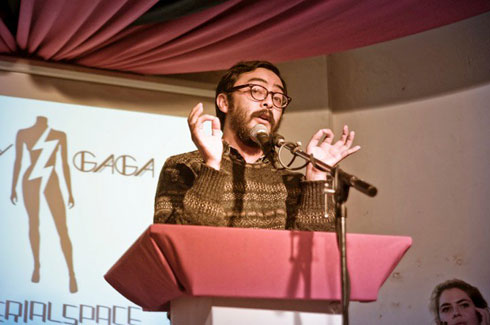
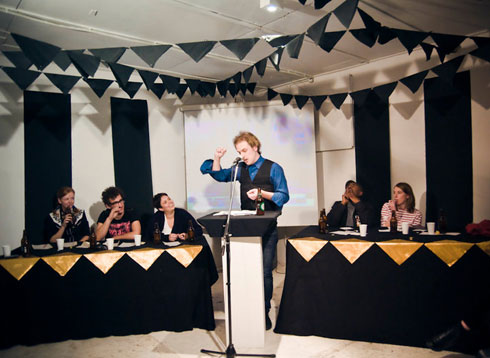 Text: Amelia Stein Images: Lucy Parakhina
Text: Amelia Stein Images: Lucy Parakhina
I’ve been to Serial Space three times. The most recent was to interview Kate Blackmore for this article and eat Indian food. Downstairs, poet Nick Keys was attempting to deliver a lecture on techne ghosts as part of a Dorkbot evening. He was struggling, bouncing a ball around to try to remember a metaphor. The rows of chairs that lined the room were full. The crowd was waiting, but they were also being patient. More than anything, they were being supportive. Eventually Keys picked up his train of thought and launched into an insightful and genuine lecture while I finished my palak paneer.
The time before that, the place was full of pink and red streamers and a giant paper heart was exerting a near-centrifugal force from the centre of the room. Two teams, seated at tables covered in red cloth, rose one by one to debate the merits of polyamory. Again, the rows of chairs that lined the room were full. The debaters yelled, shook with nerves and insulted the opposing team. They wielded copies of The Ethical Slut and frantically took notes as the crowd cheered and booed.
Then there was the first time, when I went to deliver something to a friend. The gate was open, leading to the courtyard, leading to the door. There was no sign, no exhibition, no gallery manager – just white walls, a concrete floor and a staircase. The space was empty. There was no evidence that anything had ever happened, or would ever happen, here.
Of these experiences, it is actually the last one – blankness – that has the most to say about Serial Space’s success. As much structurally as it is in nature, Serial Space is profoundly unprepossessing. It is a receptive and open platform for the values – experimentation, fluidity – of those who choose to invest, and so has the potential to fill and transform with whatever energy and initiative people throw at it.
The ideals of spontaneity and adventurousness underscore not only the diversity of events held, but also the way the events are scheduled (never more than a few in advance). Likewise, there is no rule about how often the roster of directors must change, or what is required in order to be involved.
“[Serial Space’s directors] are from really different backgrounds,” says co-director Kate Blackmore, “which I guess is why the programming is so diverse. Pia [Van Gelder] is an electronic artist and she runs Dorkbot – she’s the Overlord of Sydney – and we have regular events here, so that brings a very specific crowd. Tom Smith is more interested in experimental sound sort of stuff. Frances Barrett and I are in Brown Council, so we’re interested in bringing performance and live forms to the space. Marion [Tubbs] is doing her PhD and she’s interested in assemblage as an art form. She brings an academic, theoretical side to the programming and started Serial/in/Theory when she came on board.”
“Tom Smith recently said in an interview for Das Superpaper that ‘running Serial Space is very much a form of praxis, a way of putting our ideas and interests at the forefront of what we actually do with our time.’ We’re living our ideas about life and art merging. It’s a really creative environment to be in and doesn’t feel like we’re working when we’re running an event. It’s a very vibrant space and it’s constantly being reinvigorated by new people, new audiences. It’s a real community here, and I’ve never really experienced anything like that before.”
What Serial Space and its directors aim to provide to both artists and audiences is exactly this: an authentic experience. Most recently, they’ve been able to strengthen this exchange with two annual grant-facilitated residencies, where artists can spend three weeks developing new work in the space.
For a less unified body, this commitment to staying open could spell disorganisation at best and disharmony at worst. But somehow, for Serial Space, their flexibility has engendered absolute trust and enthusiasm from audiences and artists alike.
The clear through-line for all that Serial Space offers is the desire to bring creative output to audiences in ways that might not otherwise exist. Much of what Serial Space gets behind is art that would potentially have a hard time finding an audience anywhere else, because of its experimental or indefinable nature. Similarly, the door is always open for those who are interested in original ideas in whatever form they may take.
“With certain events, like the debate series, we want that to appeal to a really large audience,” says Blackmore. “They’re not unique social interactions. We’re interested in bringing a whole lot of people together to have a discussion in that context. We don’t want it to just be an art debate by an art crowd for an art crowd. We want everyone to be there listening to two different perspectives on an argument.“
“I love to see people in the space and to see the space active. I think that is so important. To me, that means it’s working and that we’re appealing to people who are interested and engaged with what we’re putting on. Sometimes we do have really small audiences and that doesn’t really matter. It’s not really a priority to ‘sell tickets’ – but it’s amazing when there’s heaps of people in the space and it’s alive.”
Serial Space
Next story: Sunshine Folds – Dark Bells



